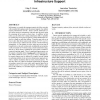Free Online Productivity Tools
i2Speak
i2Symbol
i2OCR
iTex2Img
iWeb2Print
iWeb2Shot
i2Type
iPdf2Split
iPdf2Merge
i2Bopomofo
i2Arabic
i2Style
i2Image
i2PDF
iLatex2Rtf
Sci2ools
MOBICOM
2003
ACM
2003
ACM
Throughput capacity of random ad hoc networks with infrastructure support
In this paper, we consider the transport capacity of ad hoc networks with a random flat topology under the present support of an infinite capacity infrastructure network. Such a network architecture allows ad hoc nodes to communicate with each other by purely using the remaining ad hoc nodes as their relays. In addition, ad hoc nodes can also utilize the existing infrastructure fully or partially by reaching any access point (or gateway) of the infrastructure network in a single or multi-hop fashion. Using the same tools as in [1], we show that the per source node capacity of Θ(W/ log(N)) can be achieved in a random network scenario with the following assumptions: (i) The number of ad hoc nodes per access point is bounded above, (ii) each wireless node, including the access points, is able to transmit at W bits/sec using a fixed transmission range, and (iii) N ad hoc nodes, excluding the access points, constitute a connected topology graph. This is a significant improvement over ...
| Added | 05 Jul 2010 |
| Updated | 05 Jul 2010 |
| Type | Conference |
| Year | 2003 |
| Where | MOBICOM |
| Authors | Ulas C. Kozat, Leandros Tassiulas |
Comments (0)

